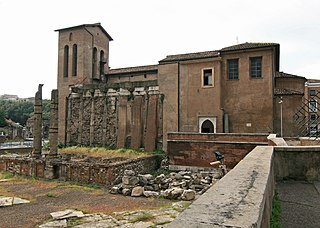Temple of Janus (Forum Holitorium)
Aedes Iani | |
 The church of San Nicola in Carcere with the remains of the Temple of Janus. | |
| Location | Rome, Italy |
|---|---|
| Coordinates | 41°53′28″N 12°28′48″E / 41.89111°N 12.48000°E |
| Length | 26 metres (85 ft) |
| Width | 15 metres (49 ft) |
| History | |
| Periods | 3rd century BC |
| Cultures | Ancient Rome |
The Temple of Janus at the Forum Holitorium is the second known temple dedicated to Janus, besides the temple of the same name located in the Roman Forum.
It is known that it stood "close to the Theatre of Marcellus" (ad theatrum Marcelli[1] or iuxta theatrum Marcelli[2]) and "outside Porta Carmentalis" (extra portam Carmentalem[3]) and that feasts took place there in August[4] and October.
It is highly likely that it is one of the three contiguous temples from the Republican era in the area of the ancient Forum Holitorium – where now stands the church of S. Nicola in Carcere – and more specifically the northernmost one, to the right than the facade of the church. The remains of the temple are seven columns in tuff - a material typical of the original age of construction and of the Roman tradition - incorporated with their architrave in the right side of the church and two columns rising on the basement just near the Theatre of Marcellus.
History[]
The temple was built by Gaius Duilius in 3rd century BC, at the time of the First Punic War, after the Roman victory at the battle of Mylae.[5]
Augustus began a restoration of the temple, a project completed by his heir Tiberius in 17 AD. According to Pliny the Elder,[6] Augustus brought a statue of Janus, a work either of Scopas or Praxiteles,[7] to be dedicated in this temple.
Description[]

The temple had a Ionic hexastyle pronaos and featured another row of six columns behind the facade and one of nine on the long side; it was nonetheless devoid of posticum, i.e. the rear colonnade, since the peristasis of columns did not cover that side.
The temple was entirely covered with peperino, like the one used for the Temple of Hadrian, and rested on a basement of concrete covered with travertine. The columns and capitals were made of marble as well, unlike the nearby Temple of Portunus which had a stucco covering. It was about 26 metres (85 ft) in length and 15 metres (49 ft) in width.
See also[]
Notes[]
- ^ Fast. Allif. et Vall. ad XVI Kal. Sept., CIL I2 p217, 240; Fast. Amit. ad XV Kal. Nov., CIL I2 p245, 325, 332
- ^ Serv. Aen. VII.607, which is an interpolation in Jordan's opinion, though this is not warranted by Thilo's apparatus criticus. It is much more likely that a scholar confused this temple with the Temple of Janus at the bottom of the Argiletum and accordingly wrote «sacrarium hoc, id est belli portas, Numa Pompilius fecit circa imum Argiletum iuxta theatrum Marcelli» (cf. LIV. I.19.2). This is the second of the alternatives suggested by Wissowa in Gött. Gel. Anz. 1904, 562.
- ^ Fest. 285.
- ^ The day of dedication was the Portunalia, 17 August; see Fast. Allif. et Vallens.; and for the significance of the fact, Pais, Fasti Triumphales Capitolini, ii.474‑478.
- ^ Tac. Ann. II.49.
- ^ NH xxxvi.28
- ^ Probably Scopas's Έρμης δικέφαλος (Hermes Dicephalus, Two-headed/two-faced Hermes, appropriate to Janus) - WR 106; Jahr. d. Inst. 1890, 148‑149.
Bibliography[]
- Rodolfo Lanciani (1985). Rovine e scavi di Roma antica. Rome: Quasar.
- Filippo Coarelli (1975). Guida archeologica di Roma. Verona: Arnoldo Mondadori Editore.
- Ranuccio Bianchi Bandinelli; Mario Torelli (2008). L'arte dell'antichità classica, Etruria-Roma. Novara.
External links[]
- "The Republican Temples of San Nicola in Carcere". Sovrintendenza Capitolina ai Beni Culturali. Retrieved 11 December 2019.
 Media related to Temple of Janus (Forum Holitorium) at Wikimedia Commons
Media related to Temple of Janus (Forum Holitorium) at Wikimedia Commons- Lacus Curtius - Platner
Coordinates: 41°53′28.6″N 12°28′48″E / 41.891278°N 12.48000°E
- Temples of the Fora Venalia
- 3rd-century BC religious buildings and structures
